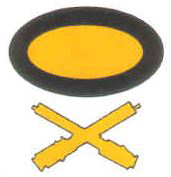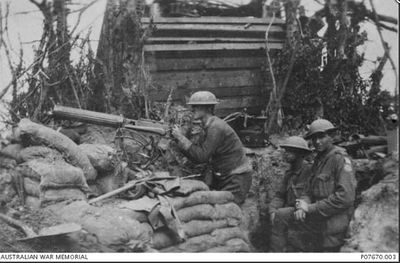3rd Machine Gun Battalion
From Our Contribution
 | |
 AWM P07670.003 | |
Contents
[hide]Brief History
The establishment of machine gun battalions within the AIF was the final step in the evolution of the organisation of direct fire support during the war. At the start of the war, Maxim machine guns had been assigned within line infantry battalions on a limited scale of two per battalion. As it was realised that there was a need for increased fire support, this was later increased to four guns per battalion, operated by a section of one officer and 32 other ranks. Following Gallipoli the machine gun sections within each infantry battalion had been consolidated into companies assigned at brigade level.
While the 3rd Machine Gun Battalion didn't come into being until March 1918, its resources were previously known as the 9th, 10th, 11th and 23rd Machine Gun Companies. The 9th, 10th and 11th having been formed in Australia during 1916 and made up the original MG Battalion with the 23rd which joined them in in August 1917 having been formed in England in January 1917.
The original companies undertook intensive training with the 3rd Division in England and arrived on the Western Front in late 1916 with the rest of the 3rd Division. During 1917 they were engaged in the battles at Messines and Ypres.
The final battalion format had a total of 64 Vickers medium machine guns, 16 per company, served by a crew of three, mounted on a tripod and they were active in the Hundred Days Offensive. Their main role being to provide enfilade fire in defence and plunging fire in support of attacking infantry. Due to the exposed position from which the machine gunners fired, they suffered heavy casualties.
Battalion Personnel
- Albert Nock 12 Oct 1917 - ?? Nov 1918
- Arthur Thomas Orton MM
Battle Honours
As a result of the decision not to re-raise machine gun battalions in the early interwar years, no battle honours were subsequently awarded to the 3rd Machine Gun Battalion – or any other First World War machine gun battalion – as there was no equivalent unit to perpetuate the honours when they were promulgated by the Australian Army in 1927[1]
Individual Honours
- 2 Distinguish Service Orders
- 5 Military Crosses
- 4 Distinguished Conduct Medals
- 28 Military Medals - (Arthur Thomas Orton MM)
- 4 Meritorious Service Medals
- 16 Mentioned in Despatches, and
- 6 foreign awards
Notes
Content for the history and honours sections has come from a combination of Wikipedia and the Australian War Memorial websites.